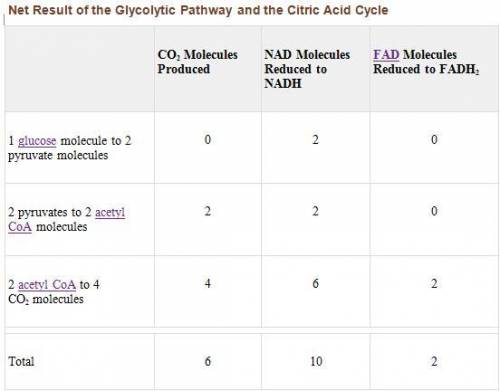
Biology, 08.01.2020 00:31 Knownothing
For each moleule of glucose that is metabolized by glycolysis and the citric acid cycle, what is the total number of nadh + fadh2 molecules produced?
a) 5
b) 12
c) 10
d) 6
e) 4

Answers: 3


Another question on Biology

Biology, 21.06.2019 20:30
For your initial isolation of the bacterium, you simply needed to grow enough of it that you could identify some of its more general features. thus, you used a complex nutrient agar that would allow for the growth of almost any bacterial species. different bacterial species often have very specific requirements for life. this is a fact that you can utilize when you are trying to identify the bacterium to the species level. growth conditions that will permit the growth of one species but not another may allow you to select which one you would like to culture. you can utilize different selective/differential media that allow for the growth of only one type of bacteria (e.g., either gram positive or gram negative). culturing media such as phenylethyl alcohol or sodium chloride agar will be selective/differential for gram-positive bacteria. you may also want to show that it is different from other bacteria that may be present, so you could use a selective/differential agar. selective/differential media such as blood agar or phenol red sugar broths allow for the determination of whether a bacterial cell can grow and utilize specific ingredients included in the medium and turn the agar a distinct color. sheep's blood agar utilizes red blood cells to differentiate which bacterial species may have hemolytic properties.selective or differential? 1. an agar that uses a high salt concentration to limit the growth of one type of bacteria over another would be considered selective/differential. 2. if an agar contains a dye or ph indicator in the presence of a sugar, it is generally considered selective/differential for those bacteria that may ferment the sugar over those that cannot. 3. an agar that uses the dye in crystal violet agar suppresses the growth of gram-positive bacteria. this agar would be considered selective/differential. 4. the selective/differential aspect of macconkey agar allows for the determination of which bacteria are lactose fermenters and which are not. 5. a blood agar plate contains sheep red blood cells and allows for the determination of hemolytic capabilities for all bacteria that grow on the agar. this would make this type of agar selective/differential. 6. emb agar uses lactose and two dyes that allow it to be selective/differential between the blue-black colonies of e. coli and the pinkish colonies of all other enteric bacteria. 7. bile salts in macconkey agar allow for the agar to be selective/differential for the growth of enteric gram-negative bacteria over gram-positive bacteria. 8. an agar that allows for the distinction of bacteria based on metabolism would be considered selective/differential.
Answers: 1

Biology, 21.06.2019 22:30
Heat from earths interior and pressure from overlying rock transform the remains of marine sediments into
Answers: 1

Biology, 22.06.2019 06:50
The kidney filters potentially toxic substances in the blood, and thus “clears” the blood of those substances. this clearance function is dependent upon and proportional to the diffusion gradient of the substance across filtering capillaries, i.e. if the concentration of the substance is doubled, twice as much will be cleared from each ml of blood that is filtered. suppose that the body produces a constant amount of a substance x per unit of time. the kidneys eliminate substance x at a rate directly proportional to the concentration of the substance and the volume of blood cleared each minute (c): elimination = c × [x], where [x] is the steady-state concentration of substance x. imagine an individual with an initial concentration of x equal to [x]0 who develops kidney disease. her baseline clearance c0 drops to one half of the original (½c0). what is the new steady state concentration of x? (for simplicity, assume that substance x is 100% filtered by the kidney).
Answers: 1

Biology, 22.06.2019 09:10
Explain the cellular functions that occur when antibiotics attack a bacteria cell. a. antibiotics target the cell wall, cell membrane, and the processes of protein and nucleic acids production in bacteria to rupture the cell. b. antibiotics create dormant resistant endospores to preserve the genetic material and rupture the cell. c. antibiotics target the cell wall and form a bridge-like connection to form conjugation. d. antibiotics use binary fission to grow twice its size, replications its dna, and split into two cells.
Answers: 2
You know the right answer?
For each moleule of glucose that is metabolized by glycolysis and the citric acid cycle, what is the...
Questions

Mathematics, 12.07.2019 13:00


Mathematics, 12.07.2019 13:00


Mathematics, 12.07.2019 13:00

Mathematics, 12.07.2019 13:00

Mathematics, 12.07.2019 13:00

Biology, 12.07.2019 13:00


Mathematics, 12.07.2019 13:00

Social Studies, 12.07.2019 13:00

Mathematics, 12.07.2019 13:00


Mathematics, 12.07.2019 13:00


Mathematics, 12.07.2019 13:00

Mathematics, 12.07.2019 13:00

Mathematics, 12.07.2019 13:00

Mathematics, 12.07.2019 13:00

English, 12.07.2019 13:00




